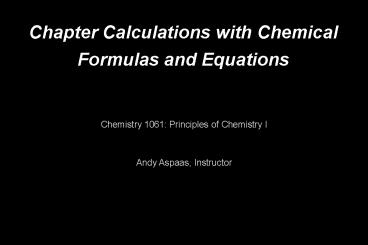Chapter Calculations with Chemical Formulas and Equations PowerPoint PPT Presentation
Title: Chapter Calculations with Chemical Formulas and Equations
1
Chapter Calculations with Chemical Formulas and
Equations
Chemistry 1061 Principles of Chemistry I Andy
Aspaas, Instructor
2
Molecular weight and formula weight
- Molecular weight sum of atomic weights for all
atoms in a substance - MW of H2O 2(1.008 amu) (16.00 amu) 18.016
amu - Formula weight same as above, but for any
compound, molecule or not - FW of NaCl (22.99 amu) (35.45 amu) 58.44 amu
3
Mass and moles
- Mole quantity of a substance that contains as
many molecules or formula units as the number of
atoms in exactly 12 grams of carbon-12 - That number Avogadros number, 6.02 x 1023
- Simply a quantity like pair, dozen, gross
- Molar mass mass of 1 mole of a substance
- Equal to formula weight of that substance!
- One mole of oxygen has a mass of 16.00 g
- One mole of H2O has a mass of 18.016 g
4
Mass and moles
- Mole calculations
- Use atomic, molecular, or formula weight as a
conversion factor in dimensional analysis to
convert between mass and moles, and vice-versa - How many moles in 100.0 g Fe? 100g of H2O?
- What is the mass of 4.72 moles of Mg? 3.25 moles
of glucose (C6H12O6)?
5
Molecules and moles
- Use Avogadros number as a conversion factor to
convert between number of particles and moles,
and vice versa - 6.02 x 1023 particles 1 mole
- Combine the two methods to convert mass to number
of particles.
6
Determining mass percentage from a formula
- Mass percentage mass of certain constituent
divided by mass of whole, expressed as percentage - Mass from formula
- Assume you have 1 mol of the substance, what mass
do you have? - Use formula to determine number of moles of each
element present - Convert moles of element to mass
- Divide mass of element by mass of compound and
multiply by 100
7
Elemental analysis
- Determines amount of C, H, and O in a compound
that contains only those elements - Compound is burned in an oven, amounts of CO2 and
H2O given off are recorded - Since 1 mol of CO2 contains 1 mol C atoms, the
mass of carbon in the substance can be found - 1 mol H2O contains 2 mol H atoms - mass of H can
be found - Mass of C and H found
- O mass is whats left over
8
Determining empirical formulas from composition
- Empirical formula simplest formula of a
substance that has all integer whole-number
subscripts - If given compositions of elements, assume you
have 100.0 g of the substance - 14.0 of an element becomes 14.0 g of that
element - Convert grams to moles for each element
- Divide all mole numbers by the smallest one
- If not all answers are integers (within
experimental error), multiply to make them all
the smallest possible integers
9
Molecular formula from empirical formula
- Molecular formula is some multiple of the
empirical (simplest) formula - Empirical formulas of acetylene (C2H2) and
benzene (C6H6) are both CH - Molecular weight n x empirical formula weight
- n molecular weight / empirical formula weight
- Multiply all subscripts in empirical formula by n
10
Stoiciometry
- Chemical equations can be interpreted as either
individual molecules or numbers of moles - N2(g) 3H2(g) ---gt 2NH3(g)
- 1 N2 molecule reacts with 3 H2 molecules to make
2 NH3 molecules - Or 1 mol N2 reacts with 3 mol H2 to make 2 mol
NH3 - Use coefficients as conversion factors when
converting moles of any constituent in a chemical
reaction to moles of any other constituent
11
Masses in chemical equations
- How many grams of a product will be yielded from
a given mass of reactant? - Do same process as before, but convert masses to
moles first, and moles back to masses - Mass NH3 --gt mol NH3 --gt mol H2 --gt mass H2
12
Limiting reactant
- Often times, one reactant will be in excess of
the other - Number of moles of product is determined by
starting moles of limiting reactant - Determine number of moles of each reactant, and
calculate how many moles of product each would
make - The reactant that makes the least amount of moles
of product is the limiting reactant
13
Theoretical yield
- Theoretical yield maximum amount of product that
can be obtained by a reaction from given amounts
of reactants - In actuality, less product is often obtained
- Losses due to side-reactions
- Losses due to incomplete separations
- Percentage yield
- (actual yield / theoretical yield) x 100

